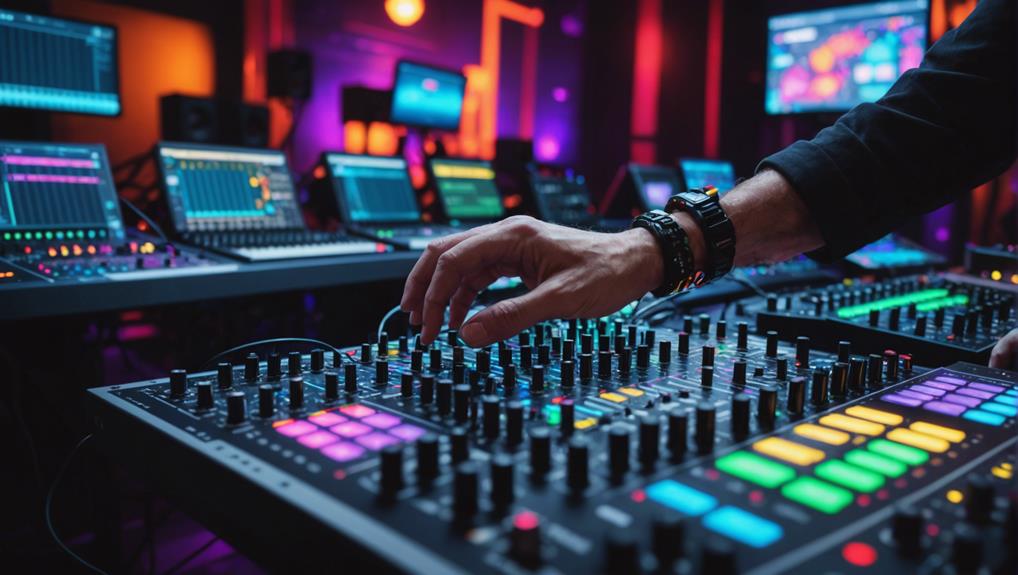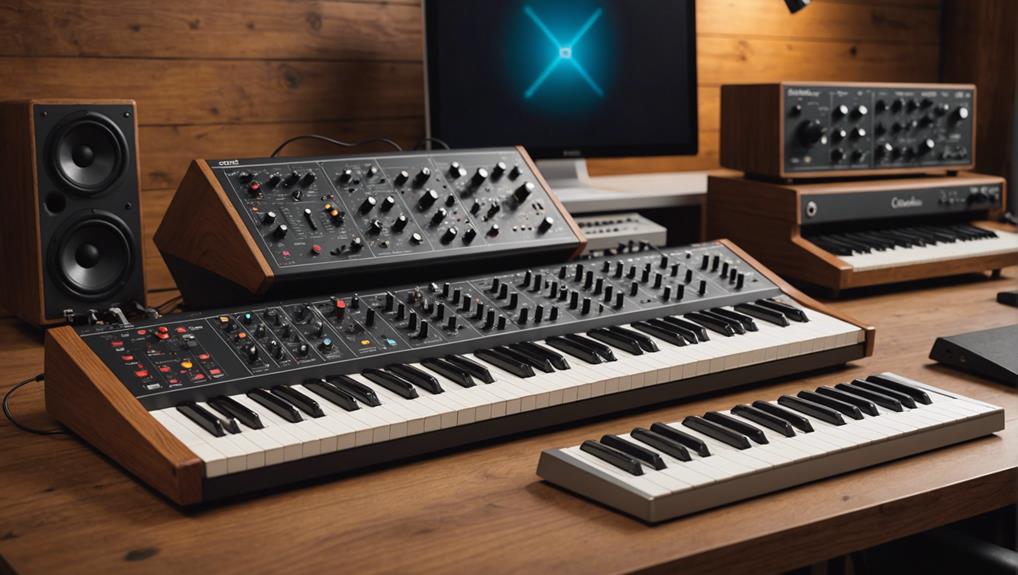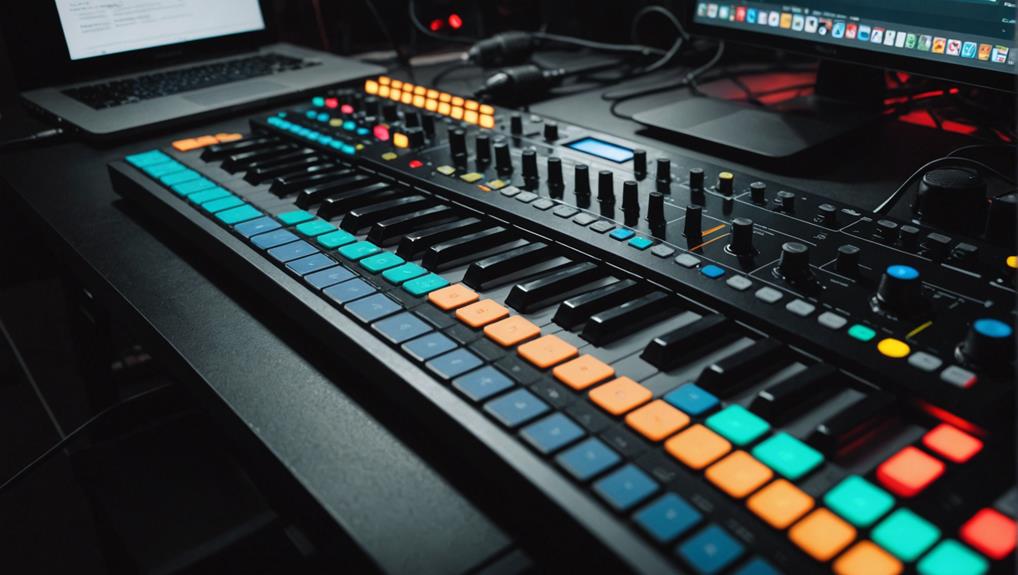No products in the cart.
To connect MIDI controllers to Ableton, first use USB MIDI connections. Confirm your controller’s compatible and activate it in Ableton’s MIDI settings. Alternatively, traditional MIDI interfaces offer stable, high-performance connections, but check the interface and controller compatibility. Configure Ableton’s MIDI preferences properly for streamlined integration. Map your MIDI controls within Ableton for best control and creativity. Synchronize your devices using MIDI clock for perfect tempo alignment. Regularly troubleshoot and update your MIDI drivers to maintain seamless performance. Each step guarantees a robust setup that could greatly enhance your music production capabilities. There’s more to explore in perfecting these connections.
Key Takeaways
- Utilize USB MIDI connections for straightforward plug-and-play setup with Ableton.
- Opt for traditional MIDI interfaces with 5-Pin DIN for reliable connectivity.
- Enable and configure your MIDI device in Ableton’s MIDI settings for proper integration.
- Use MIDI clock and time code features to sync tempo and playback position in Ableton.
- Regularly update MIDI controller drivers to ensure compatibility and optimal performance.
Utilizing USB MIDI Connections
USB MIDI connections allow you to directly link your MIDI controller to a computer without needing an additional interface. This streamlined method guarantees you’re prepared to make music with minimal setup. However, for peak performance, you need to check your MIDI controller’s compatibility. Most modern controllers are class compliant, meaning they don’t require additional drivers to function with major operating systems. But if yours isn’t, you’ll need to install specific drivers provided by the manufacturer.
Once connected, troubleshooting common connectivity issues might involve checking for firmware updates. Manufacturers frequently release updates to fix bugs or enhance functionality. You should regularly check their website to make sure your controller’s firmware is up-to-date, optimizing its performance and compatibility with software like Ableton Live.
In Ableton, go to the MIDI settings to enable your USB MIDI device. This process typically involves selecting your device as a control surface and assigning input and output ports to ensure smooth communication between your controller and Ableton. Properly setting up these parameters is essential for leveraging the full potential of USB MIDI connectivity in your music production endeavors.
Employing Traditional MIDI Interfaces
As you shift from USB to traditional MIDI interfaces, choosing the right interface is essential for peak performance with Ableton.
You’ll need to follow installation best practices, ensuring that the interface’s MIDI channels are properly aligned with your controller’s output.
If you encounter any connectivity issues, promptly checking cable connections, channel configurations, and driver updates can resolve most problems efficiently.
Choosing the Right Interface
When selecting the right MIDI interface, consider traditional 5-Pin DIN connections to guarantee stable and efficient interaction with Ableton Live. These interfaces aren’t just reliable; they’re essential for leveraging older MIDI controllers that mightn’t support USB connectivity. By focusing on interface compatibility and controller compatibility, you make sure that your setup will function seamlessly.
Here are key considerations to keep in mind:
- Interface Compatibility: Make sure the interface works flawlessly with both your MIDI devices and Ableton.
- Controller Compatibility: Check that your MIDI controller is supported.
- Cable Management: Organize cables to avoid interference and ensure a tidy workspace.
- Latency Optimization: Choose interfaces known for minimal latency to enhance real-time performance.
Installation Best Practices
Having chosen the right interface, let’s now focus on installing traditional MIDI interfaces effectively to guarantee peak performance with Ableton.
Confirm your MIDI controller compatibility by checking if both the controller and interface support 5-Pin DIN connections. This step is critical as these interfaces are prevalent in entry-level setups for MIDI integration.
Verify the correct connection of your audio interface to your computer; this alignment is essential for seamless MIDI communication. Remember, some MIDI controllers might need additional power sources to operate efficiently with the interface.
Consider adapters like the iConnectivity MioXC to facilitate smooth connectivity. These practices are essential to maintaining robust and reliable MIDI interaction with your production environment.
Troubleshooting Connection Issues
If you’re experiencing issues with your MIDI setup, first make sure that the MIDI cables are securely connected to both the controller and the interface. Following this initial check, consider these steps for a more robust troubleshooting process:
- Verify MIDI Channel Alignment: Confirm that the MIDI channels on the controller and interface are identical to facilitate clear communication.
- Update MIDI Drivers: Regularly check and update your MIDI drivers to avoid compatibility issues and aid in troubleshooting latency issues.
- Inspect Cable Integrity: Examine your MIDI cables for any signs of damage that might cause signal dropouts.
- Test on Alternate Systems: Try connecting your MIDI controller to a different computer system to identify if the issue is localized to your current setup.
Setting Up Ableton MIDI Preferences
Once you’ve opened Ableton Live’s Preferences and located the Link/MIDI tab, you’ll need to identify all available MIDI ports and make sure they’re correctly configured.
Next, adjust the input and output settings, enabling the Track and Sync options as required while keeping the Remote deactivated for output ports.
Identify Available MIDI Ports
To identify available MIDI ports in Ableton, first open the MIDI Preferences panel and check the input and output sections. This step is important for MIDI port selection and troubleshooting.
Here’s how you can guarantee a smooth setup:
- Enable the Desired Ports: Activate the Track switch for each MIDI port you intend to use.
- Select the Correct Input Device: Make sure your MIDI controller is accurately chosen in the input section.
- Verify Signal Reception: Confirm that MIDI signals are received by interacting with your controller.
- Test Controller Functionality: Check the response of your MIDI controller within Ableton to ensure everything is set up correctly.
These steps are foundational for effective MIDI channel assignment and setup guidance.
Configure Input/Output Settings
After identifying your MIDI ports in Ableton, you’ll need to configure the input and output settings in the Link/MIDI tab under Preferences to guarantee peak performance and connectivity.
First, enable the Track switch for the Output MIDI port. This allows you to send MIDI data efficiently to connected devices, making sure your MIDI controller setup is responsive and minimizing MIDI controller latency. Also, activate the Sync button to synchronize your external MIDI controllers with Ableton Live’s tempo and timing, essential for live performances and recordings.
Check your device specifications for MIDI CC support to enhance MIDI mapping techniques and ensure MIDI controller compatibility. However, leave the Remote button disabled for the Output MIDI port to prevent conflicts with other MIDI control surfaces.
Test Controller Setup
Open Ableton Live’s Preferences and head to the MIDI Link section to begin testing your controller setup. This is an essential step for both controller calibration and performance testing.
- Enable the Track Switch: Activate the Track switch for the Output MIDI port to allow MIDI data flow to your controller.
- Test Communication: Press keys or buttons on your controller to check if signals are transmitted and received accurately.
- Check Responsiveness: Ensure that Ableton Live recognizes your controller and responds to your actions without delay.
- Adjust Settings: Fine-tune settings or mappings within MIDI preferences to enhance the interaction and performance of your controller.
These steps guarantee your setup is optimized for a seamless performance.
Mapping MIDI Controls in Ableton
Mapping MIDI controls in Ableton allows you to assign hardware controller elements—like keys, encoders, and sliders—directly to software parameters, streamlining your creative workflow. This integration not only simplifies your interaction with Ableton Live but also opens up a myriad of creative mapping techniques. By utilizing various MIDI controller options, you can customize your control surface to precisely fit your performance or production style.
To start, select a parameter in Ableton that you want to control. You then move the desired MIDI controller element—whether it’s a dial, button, or slider—and it automatically links to that parameter. This method is straightforward and efficient, ensuring that you’re always in direct touch with your music creation tools.
Delving into advanced mapping strategies, you can enhance your setup further. Ableton Live tips often suggest using multiple controllers for layered configurations, enabling more dynamic performances. Experiment with assigning multiple parameters to a single controller for complex effects manipulation or split your controllers to manage different aspects of your mix efficiently. This flexibility is essential in maximizing both creativity and control in your music production.
Syncing MIDI Devices With Ableton
To guarantee your MIDI devices operate in perfect harmony with Ableton Live, you’ll need to master syncing options like MIDI clock and time code. Understanding these options guarantees that both tempo and playback positions are tightly aligned between your MIDI controllers and Ableton, optimizing your music production and live performance setup.
Here’s how you can enhance your setup:
- MIDI Clock Synchronization: Utilize MIDI clock to synchronize the tempo across Ableton and external MIDI devices. This is essential for maintaining consistent rhythmic patterns and enhancing overall performance stability.
- Time Code Integration: Sync the playback position using time code to ensure precise alignment on detailed projects, enabling more complex arrangements and live edits without timing discrepancies.
- Control Response Optimization: Set your takeover mode in Ableton to ‘value scaling’ to achieve immediate response from your MIDI control surfaces, which is essential for real-time performance tweaks.
- Performance Enhancement: Proper synchronization not only prevents timing issues but also improves the fluidity and responsiveness of your MIDI setup, leading to a smoother and more engaging live set.
Troubleshooting MIDI Connection Issues
If you’re facing problems with your MIDI controller‘s connectivity to Ableton, first make sure all cable connections are secure and correctly configured. Loose or improperly connected cables are often culprits in creating issues. After confirming the connections, check the MIDI channel settings. Incorrect settings can prevent your controller from communicating effectively with Ableton.
Next, focus on troubleshooting latency issues. Latency can be a frustrating problem, causing a noticeable delay between your action on the controller and the response in Ableton. Adjust the buffer size in Ableton’s settings; a lower buffer size typically reduces latency but may increase the load on your computer’s CPU. Find a balance that suits your system’s capabilities.
Also, consider identifying faulty cables. Faulty or damaged cables can lead to intermittent or failed connections. If you suspect a cable is the issue, try replacing it with another to see if the problem persists. This method can quickly confirm whether the cable is at fault.
Lastly, if these steps don’t resolve the issue, test your MIDI controller on another system. This can help determine whether the problem lies with the controller itself or with your specific setup. Remember, manufacturer’s guidelines are a valuable resource for additional troubleshooting steps.
Updating MIDI Controller Drivers
After addressing connectivity issues, you should also make sure your MIDI controller’s drivers are up to date to maintain peak performance with Ableton. Regular driver updates are essential not only for enhancing compatibility with the latest software but also for ensuring top functionality within your audio setup.
Here’s why updating your MIDI controller drivers is important:
- Driver compatibility: New software versions of Ableton might require updated drivers to function properly. Keeping your drivers up-to-date guarantees you won’t run into compatibility issues that could disrupt your music production process.
- Performance improvements: Manufacturers often optimize drivers to fix bugs and enhance the overall stability and speed of your MIDI controller. These updates can greatly improve the responsiveness of your device.
- Firmware updates: Occasionally, these updates include crucial firmware enhancements that support new features or refine existing ones, thereby expanding your controller’s capability.
- User experience enhancements: Updated drivers can introduce improvements that make the user interface more intuitive and user-friendly, which enhances your overall experience during music creation.
Frequently Asked Questions
How Do I Connect My MIDI Controller to Ableton?
To connect your MIDI controller to Ableton, first install any necessary drivers, ensuring compatibility. Then, troubleshoot connection issues by verifying MIDI settings in both your controller and Ableton for seamless integration.
What MIDI Controller Works Best With Ableton?
For best results with Ableton, select MIDI controllers that excel in durability and feature compatibility. Consider the Akai MPK series and Ableton Push for their robust build and seamless integration.
How to Use 2 Midi Controllers in Ableton?
To use two MIDI controllers in Ableton, connect each via USB, configure in Preferences, and assign unique MIDI channels. Enable track and remote for precise controller synchronization and best performance configuration.
How Do I Map a MIDI Controller in Ableton?
To map a MIDI controller in Ableton, enter MIDI Mapping mode, select a parameter, and tweak your controller. Utilize mapping shortcuts and controller customization to enhance precision and streamline your production process.
Conclusion
Now that you’ve explored the best ways to connect MIDI controllers to Ableton, you’re all set to enhance your music production workflow. Remember, it’s essential to keep your drivers updated and regularly check your MIDI preferences in Ableton.
If issues arise, don’t hesitate to troubleshoot. By effectively mapping controls and syncing devices, you’ll unleash the full potential of your setup.
Immerse yourself, experiment, and let your creative instincts lead the way in crafting unique sounds and compositions.




